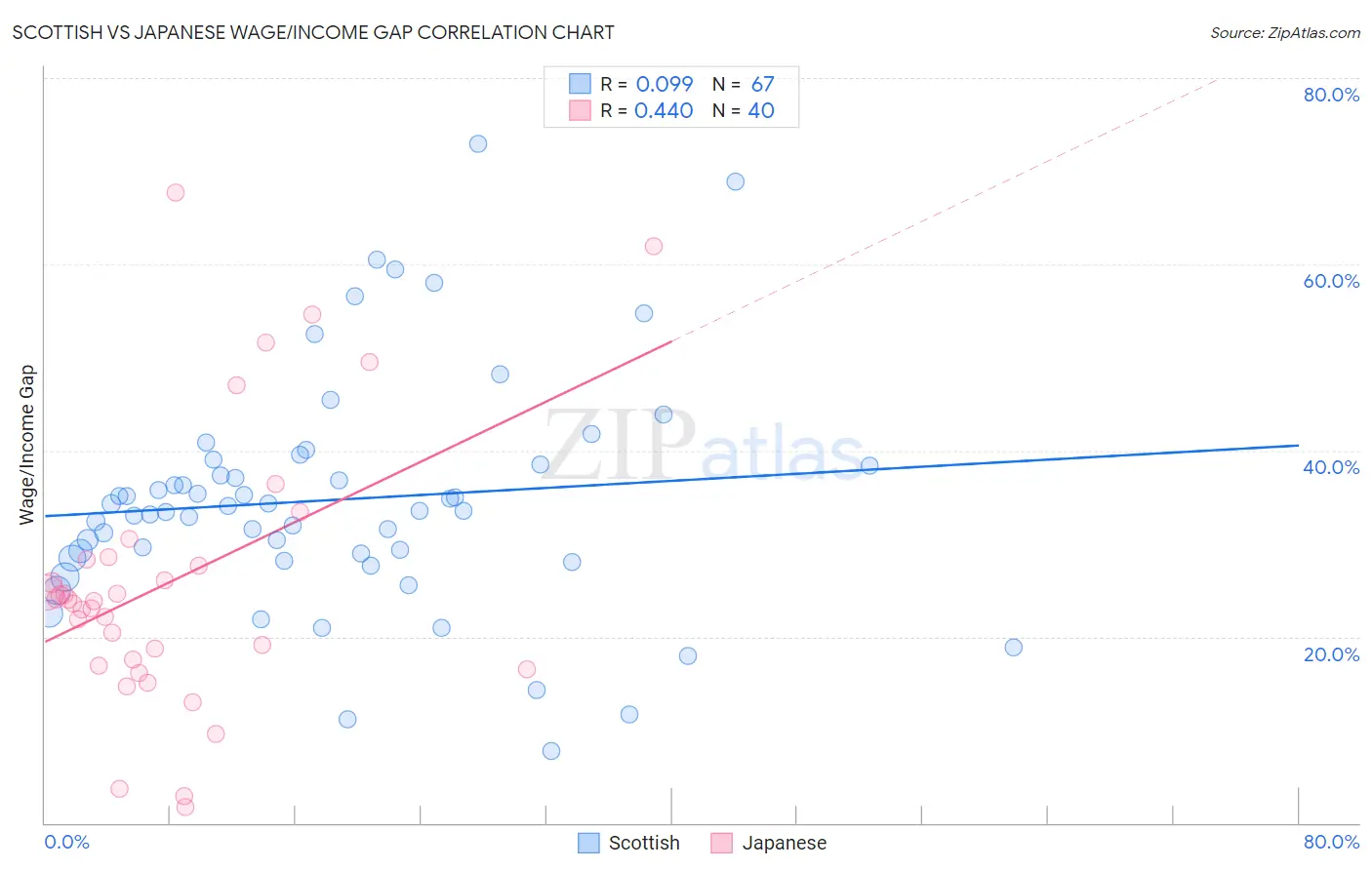Scottish vs Japanese Wage/Income Gap
COMPARE
Scottish
Japanese
Wage/Income Gap
Wage/Income Gap Comparison
Scottish
Japanese
29.1%
WAGE/INCOME GAP
0.0/ 100
METRIC RATING
329th/ 347
METRIC RANK
23.8%
WAGE/INCOME GAP
99.1/ 100
METRIC RATING
101st/ 347
METRIC RANK
Scottish vs Japanese Wage/Income Gap Correlation Chart
The statistical analysis conducted on geographies consisting of 564,295,282 people shows a slight positive correlation between the proportion of Scottish and wage/income gap percentage in the United States with a correlation coefficient (R) of 0.099 and weighted average of 29.1%. Similarly, the statistical analysis conducted on geographies consisting of 249,130,971 people shows a moderate positive correlation between the proportion of Japanese and wage/income gap percentage in the United States with a correlation coefficient (R) of 0.440 and weighted average of 23.8%, a difference of 22.5%.

Wage/Income Gap Correlation Summary
| Measurement | Scottish | Japanese |
| Minimum | 7.8% | 1.7% |
| Maximum | 73.0% | 67.8% |
| Range | 65.2% | 66.0% |
| Mean | 34.7% | 26.0% |
| Median | 33.5% | 23.9% |
| Interquartile 25% (IQ1) | 28.4% | 17.2% |
| Interquartile 75% (IQ3) | 38.5% | 28.4% |
| Interquartile Range (IQR) | 10.1% | 11.2% |
| Standard Deviation (Sample) | 12.5% | 14.8% |
| Standard Deviation (Population) | 12.4% | 14.6% |
Similar Demographics by Wage/Income Gap
Demographics Similar to Scottish by Wage/Income Gap
In terms of wage/income gap, the demographic groups most similar to Scottish are German (29.2%, a difference of 0.10%), Scandinavian (29.1%, a difference of 0.14%), Czech (29.2%, a difference of 0.15%), Immigrants from Iran (29.1%, a difference of 0.20%), and Immigrants from Belgium (29.0%, a difference of 0.31%).
| Demographics | Rating | Rank | Wage/Income Gap |
| Immigrants | Singapore | 0.1 /100 | #322 | Tragic 28.9% |
| Norwegians | 0.1 /100 | #323 | Tragic 29.0% |
| Croatians | 0.0 /100 | #324 | Tragic 29.0% |
| Hungarians | 0.0 /100 | #325 | Tragic 29.0% |
| Immigrants | Belgium | 0.0 /100 | #326 | Tragic 29.0% |
| Immigrants | Iran | 0.0 /100 | #327 | Tragic 29.1% |
| Scandinavians | 0.0 /100 | #328 | Tragic 29.1% |
| Scottish | 0.0 /100 | #329 | Tragic 29.1% |
| Germans | 0.0 /100 | #330 | Tragic 29.2% |
| Czechs | 0.0 /100 | #331 | Tragic 29.2% |
| Immigrants | South Central Asia | 0.0 /100 | #332 | Tragic 29.3% |
| Europeans | 0.0 /100 | #333 | Tragic 29.4% |
| Swedes | 0.0 /100 | #334 | Tragic 29.4% |
| Immigrants | Taiwan | 0.0 /100 | #335 | Tragic 29.5% |
| English | 0.0 /100 | #336 | Tragic 29.5% |
Demographics Similar to Japanese by Wage/Income Gap
In terms of wage/income gap, the demographic groups most similar to Japanese are Immigrants from Laos (23.8%, a difference of 0.14%), Yakama (23.7%, a difference of 0.15%), Aleut (23.7%, a difference of 0.17%), Immigrants from Latin America (23.7%, a difference of 0.25%), and Tsimshian (23.9%, a difference of 0.37%).
| Demographics | Rating | Rank | Wage/Income Gap |
| Hondurans | 99.5 /100 | #94 | Exceptional 23.6% |
| Cape Verdeans | 99.4 /100 | #95 | Exceptional 23.6% |
| Kiowa | 99.4 /100 | #96 | Exceptional 23.6% |
| Immigrants | Sudan | 99.4 /100 | #97 | Exceptional 23.6% |
| Immigrants | Latin America | 99.2 /100 | #98 | Exceptional 23.7% |
| Aleuts | 99.2 /100 | #99 | Exceptional 23.7% |
| Yakama | 99.2 /100 | #100 | Exceptional 23.7% |
| Japanese | 99.1 /100 | #101 | Exceptional 23.8% |
| Immigrants | Laos | 99.0 /100 | #102 | Exceptional 23.8% |
| Tsimshian | 98.9 /100 | #103 | Exceptional 23.9% |
| Tlingit-Haida | 98.7 /100 | #104 | Exceptional 24.0% |
| Moroccans | 98.6 /100 | #105 | Exceptional 24.0% |
| Sudanese | 98.6 /100 | #106 | Exceptional 24.0% |
| Yaqui | 98.4 /100 | #107 | Exceptional 24.0% |
| Immigrants | Albania | 98.4 /100 | #108 | Exceptional 24.0% |